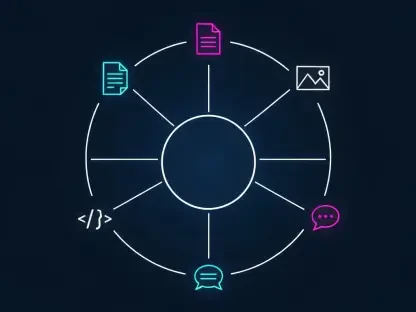Data compliance and governance have reached unprecedented levels of complexity, necessitating advanced solutions to ensure transparency, accuracy, and adherence to regulations. Solidatus is at the forefront of addressing these challenges through its innovative use of digital twin technology.
Pioneering a New Standard in Data Governance
The Evolution of Data Governance
From its origins in the 1990s with the introduction of data catalogs, data governance has become an essential component of data management, evolving to meet the demands of increasingly intricate data environments. Initially, data governance focused on relatively straightforward tasks, given the simplicity of early data infrastructures. As technology advanced and data environments expanded to include numerous systems and diverse sources, maintaining transparency and compliance became markedly more difficult. Organizations now face a multitude of regulatory requirements and need to track complex data lineage with high precision.
For example, the increased complexity mandates sophisticated tools like digital twins that facilitate comprehensive tracking of data from its origin, through various transformations, to its final use in reports and AI models. Solidatus’ approach involves creating these virtual replicas of data assets and processes, synchronized with operating systems, to simulate changes and provide in-depth analysis. Such innovative methodologies are crucial for understanding and managing the intricate web of data flows that characterize modern infrastructures.
Citibank: A Case Study in Compliance
Against the backdrop of Citibank’s regulatory challenges, including significant fines for data management failures, the necessity for robust data governance solutions becomes apparent. Citibank’s recent fines totaling $536 million for lapses in data management practices highlight the heightened scrutiny from regulators on how data is handled and protected. In response to these regulatory demands, Citibank has launched initiatives to strengthen their data governance framework, such as replacing thousands of external contractors with full-time employees. This measure aims to establish a more controlled and accountable environment for managing vast amounts of data and ensuring compliance.
Such steps underline the importance of implementing advanced data governance solutions to mitigate risks associated with data mismanagement. Solidatus’ innovative use of digital twins could play a pivotal role in helping organizations like Citibank achieve compliance by providing tools for detailed data visualization and lineage tracking. This can help banks and other financial institutions to stay ahead of regulatory requirements, ensuring data is managed responsibly and efficiently at all times.
Digital Twins: The Heart of Solidatus’ Strategy
Visualization and Granularity
Solidatus leverages digital twins to offer unparalleled visualization of data processes, enabling users to interactively trace data from its origin through various transformations to its end-use. This capability is essential for understanding complex data flows and identifying potential compliance issues. Unlike traditional data catalogs that track data at a high level, Solidatus provides column-level tracking, which offers a much finer granularity. This level of detail is crucial for verifying the lineage of data and ensuring that the information used in reports and AI models is accurate and reliable.
The emphasis on visualization allows stakeholders to gain an interactive, end-to-end view of the data journey within an organization. By offering a clear and concise visual mapping of data processes, Solidatus helps users quickly spot anomalies or inconsistencies that might indicate compliance risks. This granular approach also aids in pinpointing the exact source of any data-related issues, enabling faster resolution and better overall data governance.
Bi-Temporal Version Control
An essential feature of Solidatus’ digital twin technology is bi-temporal version control, allowing organizations to analyze historical data configurations and simulate future changes. This capability is particularly valuable for regulated industries, where maintaining a thorough record of data lineage and transformations is necessary for compliance audits and regulatory reviews. Bi-temporal version control ensures that organizations can track changes over time, providing accountability and traceability.
This functionality allows enterprises to simulate scenarios such as cloud migrations or system upgrades, assessing their impact on data governance before implementation. By doing so, they can identify potential risks and ensure that their data infrastructure remains compliant throughout changes. This forward-thinking approach not only facilitates regulatory compliance but also supports continuous improvement in data management practices.
Addressing Data Environment Complexities
The Inadequacy of Manual Processes
In large, regulated entities, traditional methods such as spreadsheets or Word documents are inadequate for managing complex data environments. These manual processes are prone to errors and inefficiencies, increasing the risk of non-compliance. They cannot keep up with the dynamic nature of modern data landscapes, particularly in organizations with extensive legacy systems and varied data sources. Manual tracking is not only time-consuming but also fails to provide the comprehensive insights needed for effective data governance.
Solidatus’ automated solutions offer a marked improvement over these outdated methods. By automating the collection and visualization of data lineage, Solidatus ensures that organizations have a clear and accurate view of their data flows at all times. This automated approach not only reduces the risk of human error but also streamlines data management practices, making it easier to maintain compliance in complex environments.
Uncovering Hidden Data Flows
Solidatus’ platform excels at identifying undocumented and unexpected data flows, which can pose significant compliance risks. Through its advanced data mapping capabilities, Solidatus helps organizations uncover hidden connections that might otherwise go unnoticed. For instance, data believed to be isolated might be found to flow into uncontrolled flat files, inadvertently exposing sensitive information. By revealing these hidden data flows, Solidatus enables organizations to take proactive measures to secure their data and prevent compliance breaches.
Understanding these undocumented connections is crucial for maintaining data integrity and preventing inadvertent disruptions. Solidatus’ detailed visualization tools ensure that organizations have a comprehensive understanding of their data environment, allowing them to identify and rectify any potential compliance issues quickly. This proactive approach enhances data security and helps organizations build a robust data governance framework.
The Role of Data Officers
The Shift in Data Management Priorities
Modern data management challenges extend beyond storage and backup to understanding data usage and provenance. The roles of Chief Data Officers (CDOs) and Chief Information Officers (CIOs) have become increasingly crucial in overseeing data quality, infrastructure, and network management. CDOs focus on the strategic aspects of data management, such as ensuring data accuracy and fostering a data-driven culture within an organization, while CIOs manage the technical infrastructure that supports these efforts.
As data environments become more complex, the need for collaboration between these roles becomes more significant. By working together, CDOs and CIOs can ensure that data is not only stored securely but also used effectively to drive business decisions. Solidatus’ digital twin technology supports this collaborative approach by providing a comprehensive view of data lineage, enabling both CDOs and CIOs to make informed decisions about data management practices.
Ensuring Data Quality and Governance
As data processes become more complex, verifying the quality and governance of data across multiple systems is vital. Solidatus’ digital twin technology provides the detailed tracking and lineage necessary for maintaining high standards of data governance. By offering granular insights into data flows, Solidatus ensures that organizations can verify the accuracy and reliability of their data, which is essential for making informed business decisions.
Moreover, Solidatus facilitates collaboration between different departments, enabling a unified approach to data governance. This holistic view is essential for maintaining data quality across an organization, ensuring that all data processes are aligned with regulatory requirements and internal standards. By providing the tools needed for comprehensive data tracking and visualization, Solidatus helps organizations build a culture of data integrity and accountability.
Regulatory Impact and Future Prospects
Lessons from the Global Financial Crisis
The 2008 financial crisis underscored the necessity of reliable data management, as poor data handling contributed to significant financial uncertainties. Many banks faced challenges in assessing their risk positions due to unreliable data sources and inadequate data governance frameworks. In response to these challenges, regulatory bodies implemented stricter data governance standards, such as the European Central Bank’s BCBS 239 standard introduced in 2013. This standard emphasizes the importance of accurate, complete, timely, and adaptable data reporting, highlighting the critical role of effective data governance.
Compliance with these regulatory standards is paramount for making trustworthy decisions in the financial sector. Solidatus’ digital twin technology aligns with these principles by providing the tools needed for comprehensive data visualization and lineage tracking. This alignment ensures that organizations can meet regulatory requirements while enhancing their data governance practices.
Building Trust in AI
Solidatus is well-positioned to address the emerging need for trust in AI systems. As AI technologies become increasingly integral to business operations, the reliability of the data used to inform AI decisions becomes crucial. Solidatus’ meticulous data lineage tracking ensures that all data used by AI systems is accurate and reliable, which is essential for building trust in AI-driven decisions. This level of trust is particularly important in regulated industries, where the consequences of erroneous AI decisions can be severe.
By providing granular insights into data transformations and usage, Solidatus enables organizations to establish a strong foundation of data trust. This foundation is critical for leveraging AI technologies effectively, as it ensures that AI models are built on verified and trustworthy data. As organizations continue to adopt AI, the role of Solidatus in ensuring data integrity and fostering trust in AI systems will become increasingly valuable.
Conclusion
The complexity of data compliance and governance has reached new heights, making it essential to have advanced solutions to maintain transparency, accuracy, and regulatory adherence. Solidatus leads the way in tackling these formidable challenges with its groundbreaking application of digital twin technology. By creating virtual replicas of data systems, Solidatus allows organizations to visualize, track, and manage their data landscapes in real time.
This innovative approach not only helps in ensuring data integrity and compliance but also facilitates informed decision-making and risk management. With growing regulatory pressures and the increasing importance of data in strategic planning, solutions like Solidatus become indispensable. They empower businesses to achieve a comprehensive understanding of their data, allowing them to streamline operations and mitigate risks effectively. In essence, Solidatus is revolutionizing the way companies handle data governance by providing the tools needed to navigate an ever-evolving regulatory landscape with confidence and precision.









